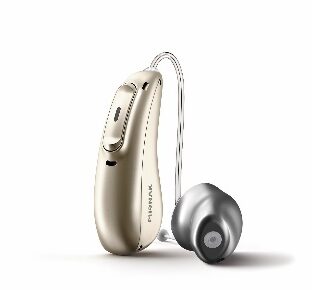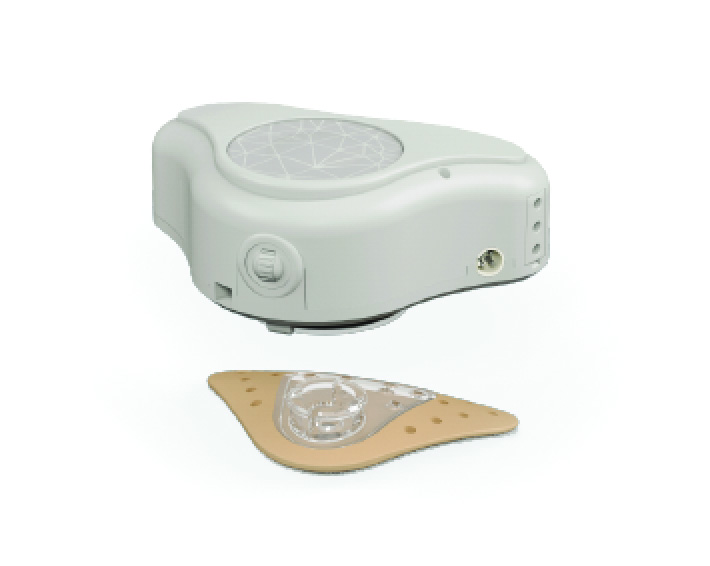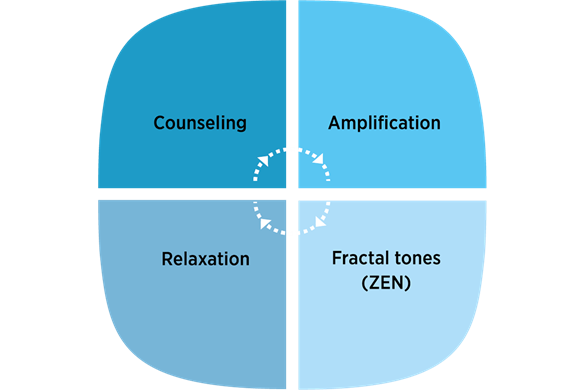Note: This article is currently being edited.
BTEs, ITEs, CICs, ITCs, bone-conduction aids, CROs aids, telecoils—the list goes on and on. Here is a handy “cheat sheet” for understanding the primary types, styles, and options in hearing aids and amplification devices.
STYLES OF HEARING AIDS
When you look at all types of hearing aids, you’ll see that they really only come in two basic styles: Behind-the-ear (BTE) and in-the-ear (ITE). As their names suggests, BTEs nestle behind your ear and have two parts: a main body and a tube or wire that transfers the sound to an earbud or a receiver in your ear canal. Although BTEs come in different styles, they all look pretty similar to each other in terms of that two-part form. Sometimes there are options for having a custom-fit earmold that fits into the outside (concha) of your ear or inside your ear canal.
ITEs, on the other hand, have styles that can look very different from each other (see below) but all are one-piece devices that fit inside your ear canal. ITEs are almost always “custom fit,” meaning that the shell is made to exactly mimic the unique shape of your ear canal.
Within these the BTE and ITE categories are several subcategories:
BTE Hearing Aids

RICs (or receiver-in-the-canal). The most popular and probably most versatile hearing aid style, RICs have a wire that extends from the main body of the aid to an earbud or “dome” which fits snugly on the outside of your ear canal (or sometimes inside the ear canal and can even be “custom fit” as explained with ITEs below). This canal portion contains a receiver; much like your stereo receiver, the receiver is the part that generates the actual sound you hear). RICs are also sometimes referred to as receiver-in-the-ear (RITE) aids. RICs make up almost 80% of all the hearing aids sold in the US, and they can fit a very broad range of losses, from mild up to profound hearing losses. The inside scoop: In a lot of cases, RICs are a great choice because they can offer all the technologies available and are extremely versatile.

Traditional BTE. A traditional BTE looks just like a RIC but is different in one important way: the traditional BTE aid has a thin transparent tube (not a wire like a RIC) that transmits the amplified sound to an earpiece, earmold, or earbud (dome) in your ear canal. Some of the tubes are extremely narrow and almost invisible (often called a “slim-tube” BTE). Therefore, all the processing and sound generation in a traditional BTE actually takes place in the processing unit over your ear. The sound then goes down the tube and into your ear, which maybe sounds a little “old-fashion” but works exceptionally well! Traditional BTEs make up about 7% of all the hearing aids sold in the US. Inside scoop:Another great solution that fits as wide a range as RICs do and feature most of the advanced technologies.
ITE Hearing Aid Styles

As mentioned, ITEs fit inside your ear. That means, in most cases, the actual “shell” of the hearing aid is “custom-fit” for the individual contours of your ear canal. This is designed to provide a comfortable, snug, acoustically perfect fit, and is usually accomplished by the hearing professional taking an actual “impression” of your ear canal using a special type of medical-grade silicon, and then sending it to a shell lab or the manufacturer for your custom aid. Some of these are fit exceptionally deep in the ear canal, providing the option of louder amplification and great acoustics (when fitted well).

However, there are also “non-custom fit” ITE hearing aids that simply slip into your ear canal for use. In fact, hearing care professionals were shocked in 2020 when a photograph revealed Queen Elizabeth was wearing a non-custom ITE and the device appeared not to be inserted properly; they questioned why the Queen of England—who presumably can afford the best hearing aid and hearing care in the world—wasn’t fit with an custom-fit ITE. However, we applaud the Queen for being the smart woman she is and taking the necessary action to benefit from better hearing!

Completely in the Canal (CIC) or Invisible in the Canal (IIC). These are the tiniest hearing aids available, and can fit mild to severe hearing losses. They’re usually favored by people who really want an “invisible” look, although increasingly the slim tube BTEs/RICs are also exceptionally inconspicuous. These aids are generally custom fit, often with the receiver going beyond the second bend of the ear canal for great sound quality. They usually have a small monofilament line with a tiny “knob” or “handle” to help you pop them out easily. A downside can be ear wax and the clogging of the receiver port. Usually these aids are all-automatic and don’t offer extensive user controls, and fewer offer all the connectivity-related features. Inside scoop: Although a great hearing solution, a lot of hearing care professionals consider them “beginner hearing aids”; most experienced wearers eventually opt for performance over cosmetics on their second purchase and buy either a larger ITE or a BTE/RIC style aid.
In the Canal (ITC). An in-the-canal (ITC) hearing aid is custom molded and fits in the outside third of your external ear. They are generally good for mild to severe losses and can feature a slightly larger battery for greater power and longer daily use. ITC hearing aids are easy to insert and remove and often offer push-button controls and/or connectivity streaming options.

ITE Half-Shell (HS-ITE) and Full-Shell (FS-ITE). Less common but still effective are the ITE half-shell and full-shell styles. These ITEs occupy a greater portion of your external ear, extending from your ear canal and resting within the contour of your external ear (with half-shells being smaller than full-shells). With their increased size and larger batteries, these ITEs can be used for a wider range of hearing losses and can feature push-button or tap controls and streaming.
And a Couple Other Hearing Aid Styles and Types…

Extended Wear (Phonak Lyric). Introduced in 2006, the Lyric is the only “extended wear” hearing aid on the market (2-3 months without taking it out) and it is sold on a subscription basis (ie, usually an annual fee covers everything). It sits deep in your ear canal and, because it has a limited battery life, it is disposable: it is replaced every few months by the hearing care professional (it can be taken out by the wearer with a special tool, but it cannot be reinserted by them for safety reasons). The Lyric is not for everyone, because some people’s ear canals are too small or are not well suited to being closed off for extended periods of time. It also doesn’t come with all the bells and whistles (eg, connectivity, fancy apps or many user controls, etc) that some other hearing aids offer. But the 24/7 ease of use has created a relatively small but loyal customer base for Lyric.

Eyeglass. If you had a parent or grandparent who used hearing aids prior to the 1980s, you probably remember the devices as being integrated into the temples of their glasses. For the most part, this style of hearing aid is not readily available anymore, although Coselgi (a WS Audiology company based in Italy), Veribel, and some other manufacturers still do make them. The ease of use and miniaturization of the BTE and ITE styles mentioned above made eyeglass hearing aids less attractive as an option. Few hearing care practices offer eyeglass hearing aids anymore.

Bone Conduction Hearing Aids/Devices. These hearing aids rely on conveying vibrations directly to the cochlea and bypassing the outer and middle ear, and they can be particularly useful for single-sided deafness (note: you should always see a doctor or hearing care professional immediately if you experience single-sided hearing loss). The most popular system for achieving this is a bone-anchored surgical hearing implant, with the primary devices being Cochlear’s BAHA, Med-El’s Bonebridge, Oticon’s Ponto, and MedTronic’s Sophono systems (also see our article on implants). However, there are a few options to a surgically implanted bone-conduction system. Med-El offers an innovative bone-conduction hearing aid called ADHEAR, and Ear Technology Corporation offers a hearing aid called TransEar which resembles a half-shell ITE except instead of sound it uses a small electro-mechanical oscillator to generate vibrations to the cochlea. There are also a wide variety of relatively inexpensive bone conduction headsets that you can obtain online, and Coselgi makes an eyeglass bone-conduction aid.
CROS and BiCROS Hearing Aids. And speaking of single-sided deafness or people who have a hearing loss on one side where it cannot be aided with amplification, there are CROS and Bi-CROS hearing aids. The CROS stands for contralateral routing of signals which is audiology-talk for transmitting the sound from the “bad” ear to the “good or better” ear. The American Academy of Audiology (AAA) website describes this well: “Contralateral routing of signal (CROS) amplification systems are intended to be used when (essentially) one ear is normal or has a mild/moderate hearing loss (ie, is generally a candidate for amplification) and the other ear is (more-or-less) not ‘aidable.’ CROS hearing aids might be recommended for single-sided deafness (SSD) or for people with very poor unilateral word recognition scores [ie, they can’t hear conversations except from the good/aidable ear]. BiCROS (Bilateral microphones with contralateral routing of signal) amplification systems are sometimes recommended when both ears have hearing loss, but one ear hears substantially ‘better’ than the other.”
OTHER HEARING AID FEATURES AND CONSIDERATIONS

Battery sizes and power options. Hearing aid batteries come in a variety of sizes and chemistries. Rechargeable hearing aids are now the most popular type (about 60% of all RICs sold in 2020 were rechargeable) and work the same as cell phones and other rechargeable devices: you place the hearing aids in the recharging cradle overnight so you can use them in the morning. Most use USB type plug-ins for recharging. Zinc-air button cell batteries are also widely used and come in (from smallest to largest) sizes 5, 10, 312, and 675. How long they last generally depends on the hearing aid, the features you use, (eg, streaming music is energy intensive), the size of the battery (bigger batteries contain more energy), and how often you’re in a setting where the hearing aid is working with speech and/or noise (again, requiring more processing and energy).

Telecoil (T-Coil). A fairly large proportion of hearing aids include a telecoil—and some hearing aid owners don’t even know if they have it! A telecoil is a tiny sensor in the hearing aid that picks up the magnetic energy transmitted from a telephone, PA system, or some other sound systems. For large group listening, it requires installing a wire loop or array of loops in a facility’s floor or ceiling, so some facilities have them and some do not. But, increasingly, they’re the ADA-compliant system of choice when it comes to theaters or large-area lecture halls. What’s especially cool about them is users only need to activate their T-coil in order to hear the sound from a stage, TV, or at the airport, and telecoils in remote mics and streamers allow users of the smallest Mini RICs to hear in a loop. You can also install a much smaller version of a loop system in your home or living room and enjoy personalized TV sound. While it’s expected that telecoil technology will eventually be supplanted by wireless receivers, they are remain extremely useful.

Connectivity. Increasingly, advanced hearing aids (and PSAPs) use Bluetooth and other wireless technology to connect with smartphones, including phone calls, music, video, Siri or Alexa personal assistants, YouTube, games, etc. In most wireless/Bluetooth hearing aids, you can also download apps that double as a remote control for volume settings, give you the ability to create special personalized listening programs, and provide fine-tuning and even remote assistance from your hearing care provider. Some of these only connect to iPhones, some connect to Android, and some are more universal in scope. If you’re interested in connecting your particular phone and/or computer, make sure to have this discussion with your hearing care professional or check into the specs of the device. The inside scoop: Some device manufacturers are a little cagey or ambiguous about compatibility. If connectivity is important to you, make sure your phone is compatible with their hearing device!
Channels and Bands. This is probably the most confusing of the “hearing aid feature” classifications, and at the risk of making hearing aid engineers mad, we’ll be frank: the number of frequency channels and bands available are almost unlimited in today’s most advanced digital hearing aids. Bands and channels have to do with grouping select frequencies so the hearing aid can be “tuned” to your individual hearing loss (ie, like a sound mixing board for a rock band). The idea is that, with a lot more bands or channels, the more precise the tuning can be. And this is probably true. We could go into a detailed explanation of the two terms, but a lot of the talk today about channels and bands boils down to marketing hype. A top-of-the-line hearing aid does generally have many adjustable bands or channels. However, if a device offers more than 3-6 bands or channels, there’s a pretty good chance that the hearing care provider can do a decent job in fitting the hearing aid to your individual hearing loss, or in the case of a self-fit device, it can be adjusted enough so you can obtain at least some hearing benefit from it.

Motion and/or Fall Sensors. Increasingly, motion or “intertial” sensors are being built into hearing aids so they can better understand the environment you’re in. For example, if you’re walking through a cafeteria, it’s likely you’ll want to hear things from all sides; however, once you sit down and engage in conversation with someone, you’ll probably want to hear the person you’re facing. The motion sensor can help determine this. Some other motion users are being used as activity trackers, counting steps similar to a FitBit and reporting it on an fitness app. At least one manufacturer (Starkey) is offering the option of using the motion sensor to alert a loved one or caregiver should the hearing aid user fall while wearing the hearing aid. Many hearing care experts believe future hearing aids might one day be able to contain other sensors that clue people in an alert about heart rate, body temperature, and other vital signs.

Tinnitus relief programs and apps. The most effective solution for people who suffer or want relief from their tinnitus (ringing in the ears) is generally a hearing aid, and about 80% of people with tinnitus have hearing loss (and visa versa). Hearing aids don’t “cure” tinnitus, but they can raise the environmental sound level so that tinnitus becomes less intrusive or even imperceptible. Skilled hearing care professionals can also insert noise at a particular frequency (called tinnitus masking) and/or create hearing aid programs for relief from tinnitus. Similarly, there are hearing aids that offer dedicated tinnitus programs. For example, the Widex Zen program produces non-repeating musical chimes that can mask or distract the wearer from their tinnitus (similar to tinnitus sound therapy programs). Along the same lines, if you have a hearing aid with Bluetooth connectivity, there are many tinnitus, relaxation, meditation, and nature-sound apps that can be downloaded from an app store, and some people find these helpful for tinnitus relief and/or for falling asleep at bedtime (some tinnitus sufferers also use an aquarium with an external filter to create the sound of trickling water which can help mask tinnitus).
Recent Comments